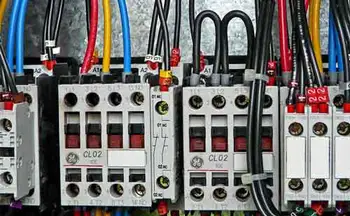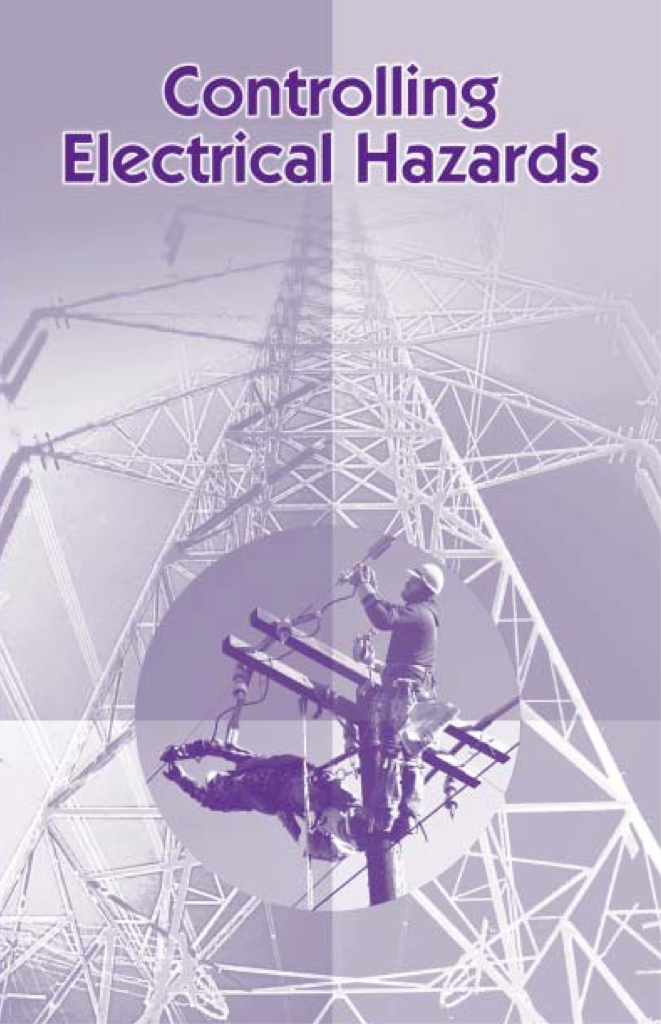Electric Motor Control Explained
By R.W. Hurst, Editor

Motor Control Training
Our customized live online or in‑person group training can be delivered to your staff at your location.

- Live Online
- 12 hours Instructor-led
- Group Training Available
Download Our OSHA 3075 Fact Sheet – Understanding Electrical Hazards in the Workplace

- Learn the effects of electric current on the human body
- Understand OSHA safety standards and protective devices
- Discover essential lockout/tagout and grounding practices
Electric motor control manages speed, torque, and performance of AC and DC motors. Using controllers, drives, and automation improves efficiency, reduces energy costs, enhances reliability, and ensures safe operation across industrial and commercial systems.
What is Electric Motor Control?
Electric motor control involves regulating motor speed, torque, and protection through devices such as controllers, drives, and starters to ensure efficient and safe operation.
✅ Improves efficiency and reduces energy waste
✅ Provides safe and reliable motor performance
✅ Supports automation in industrial applications
Electric Motor Testing Training
Request a Free Training Quotation
Importance of Electric Motor Control
Efficient and reliable electric motor control (EMC) is essential in industrial, commercial, and institutional power systems. It encompasses the management and regulation of electric motors, such as AC servo motors, brushed DC motors, and brushless DC motors, to achieve desired performance outcomes like speed, torque, and direction. This article delves into various aspects of EMC, including systems, components, and applications. To better understand the fundamentals of electric motors and drives, it is essential to examine how motor control integrates into the broader power system design.
An example of EMC in an industrial setting is the operation of conveyor belts, pumps, or HVAC systems. The coordinated and precise movement of these machines relies on an array of regulation components, including motor control centers (MCCs), motor control circuits, programmable logic controllers (PLCs), and electronic devices such as variable speed drives. Learning about electric motor efficiency demonstrates how regulation strategies and drives can significantly reduce energy waste.
Types of Motor Control Methods
There are four primary types of motor control methods: direct-on-line (DOL) motor starters, soft starters, variable-frequency drives (VFDs), and closed-loop regulation systems. Each method has specific applications and benefits, depending on required performance, energy efficiency, and system complexity.
Electricity Today T&D Magazine Subscribe for FREE

- Timely insights from industry experts
- Practical solutions T&D engineers
- Free access to every issue
-
DOL starters: Simple and cost-effective, DOL starters provide full voltage to the specific motor upon startup. However, they can generate a high inrush current, which can potentially cause mechanical stress on the motor and power system.
-
Soft starters: By gradually ramping up the voltage, soft starters reduce inrush current and offer a smoother startup.
-
VFDs: VFDs enable precise regulation of speed, torque, and direction by modulating the frequency and voltage supplied to the motor. VFDs are used in applications that require varying speeds and loads, as well as the ability to stop the motor, such as HVAC systems and pumping stations. For practical applications, how a VFD works explains the link between variable frequency drives and precise motor control.
-
Closed-loop systems: Closed-loop regulation systems utilize feedback mechanisms to monitor and adjust motor performance based on preset parameters. PLCs often coordinate multiple motors within a system and ensure seamless integration.
Modern electric motor design significantly impacts how control systems regulate torque, speed, and energy efficiency in industrial applications.
Control Algorithms and Modulation Techniques
Modern EMC goes beyond hardware—it relies heavily on advanced control algorithms.
-
Pulse-Width Modulation (PWM): Used in drives to regulate voltage and current precisely, improving energy efficiency and reducing harmonic distortion.
-
Field-Oriented Control (FOC): Enables precise torque and flux control in motors, especially PMSMs and induction motors, improving performance under variable loads.
-
Scalar vs Vector Control: Scalar control regulates magnitude (voltage/frequency), while vector control manipulates torque and flux independently for higher precision.
-
Sensor vs Sensorless Control: Encoders and resolvers provide accurate feedback sensors for speed and torque, while sensorless algorithms reduce costs and improve reliability.
These techniques enhance speed regulation, torque control algorithms, and overall energy savings. Safety is another critical factor, and systems such as motor overload protection are essential for protecting equipment from electrical and mechanical stress.
Motor Types and Trade-Offs
While EMC applies to all motors, different types present unique benefits and challenges:
-
Permanent Magnet Synchronous Motors (PMSM): High efficiency and power density, but higher initial cost.
-
Induction: Rugged, low-cost, reliable; less efficient at variable speed without VFDs.
-
Stepper: Precise positioning, but with limited torque and lower efficiency.
-
Switched Reluctance: Simple and robust, with lower costs, but they generate higher noise and torque ripple.
Comparing costs, efficiency, starting torque, and regulation complexity enables engineers to select the most suitable device for each application. Advanced regulation often relies on specialized machines, and synchronous motors show how precise speed regulation and power factor correction enhance performance in demanding environments.
Electric Motor Control Methods Overview
| Method | Description | Benefits | Considerations |
|---|---|---|---|
| Direct-On-Line (DOL) | Supplies full voltage directly at startup. | Simple, low cost, quick start. | High inrush current, mechanical stress, limited to small motors. |
| Soft Starter | Gradually ramps up voltage to reduce starting current and stress. | Smoother startup, reduced mechanical wear, extends equipment life. | Limited speed control, higher cost than DOL, less precise than VFDs. |
| Variable Frequency Drive (VFD) | Controls speed and torque by varying frequency and voltage supply. | Energy savings, precise speed regulation, torque control, bidirectional. | Higher upfront cost, generates harmonics, requires EMI/EMC mitigation. |
| Closed-Loop Control System | Uses feedback sensors (encoders, resolvers) to adjust performance. | High precision, adaptive performance, improved efficiency. | More complex, higher cost, requires sensors and PLC integration. |
EMI/EMC and Standards Compliance
Electric motor systems can generate electromagnetic interference (EMI) that affects nearby equipment.
-
Sources: High-frequency switching, harmonics, and conducted or radiated emissions.
-
Standards: Compliance with IEC 61800-5-1, IEEE, UL, and CE ensures safety and electromagnetic compatibility.
-
Mitigation Techniques: Filtering, shielding, grounding, harmonic suppression, and ESD protection devices are essential in drive systems.
Proper EMI/EMC design reduces risk, improves reliability, and ensures regulatory compliance.
Thermal, Mechanical, and Wiring Design
Designing an EMC circuit involves not only choosing components but also managing physical stresses.
-
Cooling requirements and heat dissipation must be considered to prevent overheating.
-
Insulation classes ensure motors operate safely within their rated ambient temperature.
-
Wiring gauge and voltage drop calculations prevent energy loss.
-
Enclosure protection (IP rating) safeguards against dust, water, and mechanical damage.
These factors extend equipment life and enhance protection.
Real-World Examples and Case Studies
Quantitative results show EMC’s impact:
-
A VFD in an HVAC system can reduce energy consumption by up to 40% while lowering mechanical stress.
-
Soft starters decrease startup current by as much as 60%, extending equipment life.
-
Closed-loop systems with PLC coordination have demonstrated improved efficiency class ratings in industrial trials.
These examples highlight tangible energy savings and operational benefits.
FREE EF Electrical Training Catalog
Download our FREE Electrical Training Catalog and explore a full range of expert-led electrical training courses.

- Live online and in-person courses available
- Real-time instruction with Q&A from industry experts
- Flexible scheduling for your convenience
Motor Control Centers and Panels
MCCs are crucial in organizing and managing regulation components in industrial settings. An MCC is a centralized panel that houses starters, overload protection devices, and control components, such as variable-speed drives. These panels streamline electrical power distribution, facilitate system monitoring, and enhance safety by providing a single point of control and maintenance.
A motor control panel houses key components like starters, circuit breakers, and PLCs. These panels provide a centralized location for controlling and protecting devices, ensuring efficient operation and maintenance.
Role of PLCs in Motor Control
PLCs are the “brain” of EMC systems. They process input from sensors, execute controller firmware and logic, and send commands to motor control devices. By coordinating multiple devices, PLCs enable closed-loop regulation, ensuring smooth torque regulation, overload protection, and optimal performance across VFD systems.
Emerging Trends and Modernization
The future of motor control lies in digitalization and integration:
-
IoT Monitoring: Real-time data from connected devices enables remote diagnostics.
-
Predictive Maintenance: Analytics predict failures, reducing downtime.
-
Smart Controllers: Combine sensing, protection, and regulation in one compact unit.
-
Digital Twin & Industry 4.0: Simulations Optimize Performance Before Deployment
-
Cloud Analytics: Aggregated sensor data drives insights into efficiency and reliability.
These technologies ensure motor control systems evolve with modern industrial demands. Improving reliability depends on proactive care, and exploring efficiency opportunities through motor maintenance shows how proper regulation extends device life and reduces costs.
Frequently Asked Questions
How Can Motor Control Enhance Energy Efficiency?
EMC can be used to improve energy efficiency and save your company money by:
-
Implementing VFDs for optimal variable speed regulation and load matching.
-
Upgrading to energy-efficient models for lower bills and reduced heat.
-
Using soft starters to reduce inrush current and extend lifespan.
-
Employing closed-loop systems with sensor feedback for precise performance.
-
Performing regular maintenance to minimize energy losses.
-
Optimizing sizing and selection to match load demands.
How does closed-loop control differ from open-loop?
Closed-loop systems utilize feedback sensors, such as encoders or resolvers, to adjust performance automatically, whereas open-loop systems rely solely on preset commands without feedback.
When should I use a soft starter vs a VFD?
Soft starters reduce startup current and mechanical stress, while VFDs provide full variable speed control, torque regulation, and energy savings.
What safety standards apply to motor control systems?
Standards include IEC 61800-5-1, UL safety codes, IEEE protection guidelines, and local electrical codes, ensuring compliance and protection.
EMC is vital to industrial, commercial, and institutional power systems. Proper selection, design, and maintenance of components can optimize system performance, enhance energy efficiency, and prolong equipment life. By understanding the various types, regulation algorithms, and regulatory requirements, engineers can fully harness the potential of EMC technology.
Related Articles











